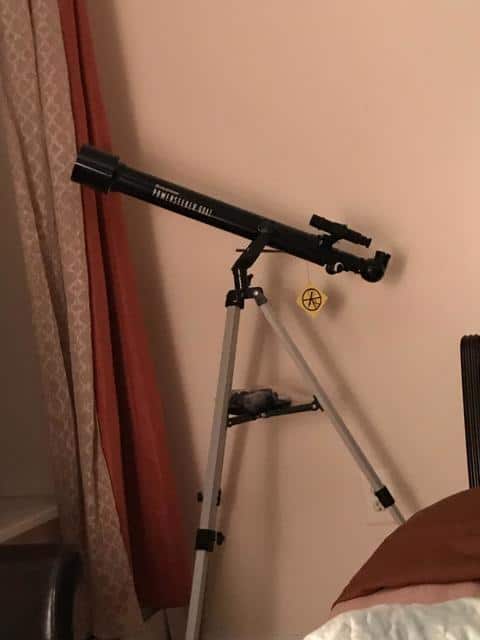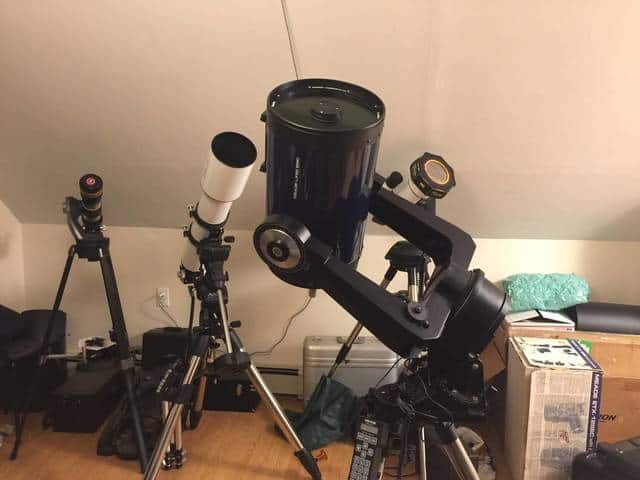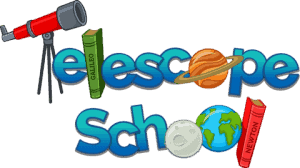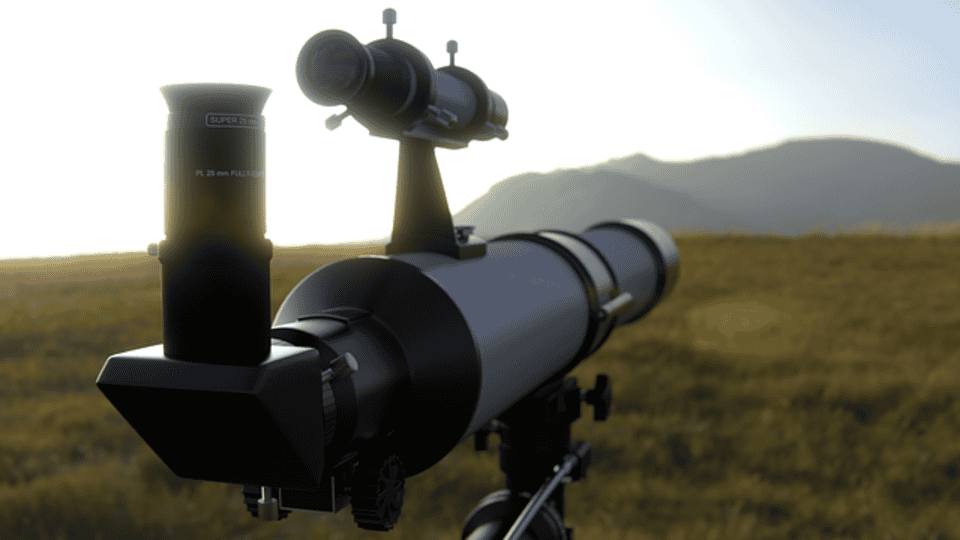You got to start somewhere, right? 9 times out of 10 we start at the beginning and knowing what may be best for a beginner could save us some time hopefully
The best telescope for a beginner is based on ease of setup, ease of use, and purchase price. Typically a refractor under 4″ checks all the boxes. Knowing your desired celestial targets is a big plus for determining which telescope is best.
Choosing observational astronomy as a hobby is an excellent decision, and picking the best telescope for that hobby can be challenging. Rather, if it is for yourself, or as a gift to someone. In general, you need to consider three main factors – price, celestial targets, and telescope specifications.
Three Things You Need to Consider
Before buying your first telescope, know first the three crucial factors you need to consider – field of study, price tag, and the place and procedure of using it. Here, we are going to have a more in-depth discussion about the three things.
Field of study (moon, planets, or deep space objects)
For an amateur astronomer, you have three choices for your first observational astronomy, that is, the moon, solar system planets, and deep space objects. There are different telescope requirements for each object to have a perfect view of them.
Observing the moon and planets in our Solar System, they emit enough brightness already, so aperture diameter will be of lesser emphasis for this field of observing. And just the curious beginner can get more bang for their buck with good binoculars. Click here to see how recommended stuff page. However, if you really want to study planets, this is where it starts to get more complicated.
Telescopes gain an advantage over binoculars because to start and see planets with detail, you start needing bigger apertures and more magnification. The best telescope for planet observing is a Cassegrain style telescope. You can learn more about Cassegrain’s by clicking here.
Cassegrains are a “slow” telescope which is more preferred when viewing the planets. Telescopes with high focal ratio are called “slow” telescopes, meaning they have longer focal lengths. Typically, choosing a scope with a focal ratio above f/8 is referred to as “slow” scope.
Aperture
In terms of aperture, an excellent telescope for beginners must have an aperture size above 70mm, preferably, between 80 mm (3.15″) to 300 mm (12″). The aperture affects the amount of light collected from the object. The larger the aperture, the more light that is focused toward your view, thus giving more significant details of an object. What is a Telescope aperture , and is there a best size?
Better quality optics are more important than having a large aperture. An 80 mm refractor with high-quality optics is better than 150 mm reflector with low-quality optics for viewing the moon and the planets. On the other hand, for deep space objects, and for the same price, a 150 mm Newtonian scope is better compared to an 80 mm Refractor.
Focal Ratio
Focal ratio is also an essential factor to consider for the type of objects to be viewed. Focal ratio is the result for dividing the focal length by aperture of the objective lens or mirror. For excellent viewing of the planets and the moon, you need to have a high focal ratio, that is a smaller field of view and high magnification. A telescope with a focal ratio f/10 is suitable for this.
Meanwhile, if you want to have a wider view of galaxies and star groups, you need to choose a scope with a lower focal ratio – wider field of view and lower magnification. Also known as a fast scope. A telescope with a focal ratio of f/5 is excellent for this viewing. Most Dobsonians are around an f/5.
To learn more about magnification, try out our calculator, or check out this article for more in-depth coverage on it.
You also may what to check out what the 50X Rule is for a telescope too.
Price Tag – How Much You Want To Spend
Observational astronomy is a productive and rewarding hobby to have but can come with a challenging cost, it totally depends on how much you want to shell out for a good telescope.
In general, there are pros and cons to different types of telescopes. Typically, a refractor type has higher retail cost than its reflector counterpart once you get over 100mm in aperture size. The price for a good 70mm scope can start from $90 and go up from there.
Bear in mind, that the quality of the optics increases as the price goes up, so you always get what you pay for.
Telescopes which fall for mid-range price and quality include 90 mm to 130 mm Mak-Cas, 150 mm Reflectors, and 90 mm to 120 mm Refractors. If you aim for viewing deep-space objects (DSOs), then the aperture of the scope should be 140 mm and larger.
The expensive and large scopes include 120 mm to 150 mm APO Refractors, 200 mm to 250 mm Schmidt Cassegrain, and 200 mm to 300 mm Newtonian.
Where Should I Use it
Once you have your telescope, the next step is finding an excellent spot to try it out and familiarize the tool. No matter how great the specifications of your scope, light pollution will always get in the way for your maximum experience.
At home, you can try out your telescope in an open-space front or backyard. Another good place to try it out is in your balcony facing the open dark sky. Typically, as light pollution intensifies, the chance of seeing deep space objects decreases dramatically. Consequently, the best way to counter this is to use LPR filters or the Broadband Light Pollution Reduction filters. Learn more about filters click here.
Further, there are six areas in the United States where you can have your ultimate stargazing experience. There may be way more, but we made sure the following sites were on several lists. Also, check out our article on how to determine How Dark Your Sky Is Above You.
- Flagstaff, Arizona
- Borrego Springs, California
- Torrey, Utah
- Headlands International Dark Sky Park, Michigan
- Staunton River State Park, Virginia
- Chaco Culture National Historical Park
- Cherry Springs State Park, PA
How to Use Your Telescope
This can be obvious by looking through the little end, right? Well, you should practice assembling and take time to align everything in the day. For more information on setting up your telescope for the first time, click here to this article.
Decide The Age of The Beginner Astronomer
There is no specific age requirement for a child to start exploring the stars, the moon, and the galaxies. Children as young as three years can already begin their star exploration with the help of their parents. Parents can start by telling stories and reading books to their kids about these things.
Some manufacturers offer a battery-operated telescope with 4x power that does not need any focusing as it has a wide eyepiece for clear views. These models can be used for children age 5 to 8 years. Although they will probably become quickly dissatisfied with the abilities of the scope.
Indeed, we can never limit the curiosity of a child and their pace of learning. All we can do is provide helpful guidance and coaching towards their learning and exploration.
The Astronomer Under 10 Years of Age
When it comes to telescopes best for children under 10 or 12 years, a refracting type is an excellent option. These types have a large lens at the front end that focuses light toward the other end of your eyepiece.
To better understand why these types are more suitable for kids younger than 10 years, here are its benefits.
- It has a simple and straightforward design for kids.
- Suitable for viewing objects near Earth, such as the moon, close planets, and some stars.
- The sealed tube of this type provides better protection for its optic system.
- It requires less maintenance than reflecting telescopes. Likewise, its design and structure are robust for kids.
- With an Alt-Az mount, it has the most straightforward setup.
Here is an example of refracting telescopes best for kids under 10 years from Amazon. It is considered the starting point and go up from there.
This one is easy to set up without tools and manipulation for kids comes pretty straightforward. It offers 175x magnifying power to give a decent view of the Saturn. Adding improved eyepieces to this would improve its view ability and help keep the child from getting bored and running out of stuff to view.
What’s Best If for a Beginner Over 12 Years of Age to Adult
Generally, any of the following are great; reflector, refractor, and compound telescope for beginners over twelve. In choosing which scope is best, you must consider price, quality, and target objects for viewing.
Here are the telescope styles explained for this age bracket.
-
For a Refractor Style
This style in this age group would want more out of the scope. Having longer attention spans an equatorial mount may be best. APO lenses offer better overall viewing, and any refractor scope with APO you can afford is good. Otherwise, the bigger the aperture, the better.
-
For a Reflector Style
In reflector style, we are going to separate kids from adults for a beginner scope. With kids, and being over twelve, a good brand 127mm aperture on an equatorial mount would be preferred. Adults, I would recommend a Dobsonian style for its very large aperture and ease of use. It is up to you, the idea is to capture light and funnel it to your eye. Although a Dobsonian typically is like an alt-az mount, you can get motorized Dob’s to help track objects. Like this Dob on Amazon
-
For a Compound, or Cassegrain Style
Cassegrains come in mostly the 2 styles of Schmidt, or Makustov. A Makustov, often Mak for short has the longest focal length and is the slowest telescope and arguably the best for planetary viewing. All Cassegrain’s tend to be of higher quality when made giving way to possible astrophotography. The downfall to these guys is the high focal length makes them harder to use for deep space objects.
Best Telescope that’s Easy to Use and Setup
This telescope would be a refractor telescope with an Alt-azimuth mount. 70mm or larger, preferably 80mm or larger aperture diameter
For beginners, it is best to choose a telescope that is easy to use and setup. In this way, you can have less hassle in manipulating the tool and familiarizing yourself with astronomy.
The Most Versatile and Best Telescope for Your Wallet
For an economical price compared to other styles, you can get a decent reflector telescope that is lightweight and simple to use once setup. Though it may not seem easy at first, collimating a reflector style scope is not that bad. Especially when you add a collimating tool that speeds up the task. Recommend aperture sizes 127mm and above.
The overall features of this telescope will enable you to view clear details of the moon, and on the planets, some details will start to be present on Venus, Mars, rings of Saturn, and Jupiter’s atmospheric conditions. Also, some deep space objects can be found and viewed with a good reflector scope.
Best Telescope For the Planets
When choosing for the best telescope in viewing planets, you must consider the quality of the optics aside from large aperture. These planets mostly emit a sufficient amount of brightness, so a very large aperture isn’t necessary. Consequently, an 80-mm refractor with good quality optics is better than 120-mm reflector with cheap optics.
Bear in mind that these planets do not stay in one place, they slowly move in an arc through the sky. An equatorial mount is most preferred over the alt-az to keep viewing and track the object through the sky. Moreover, telescopes with longer focal length provide better planetary viewing leaving the answer of the best telescope for planet viewing as Cassegrain’s.
Best Telescope For Deep Space Objects
Aside from the moon and the planets, few beginners get to view deep space objects such as galaxies, star clusters, and nebulae. To perform DSO observation effectively, your telescope must have a large aperture, excellent optics, and preferably equatorial mount to do arcing movements with stars.
If you have extra budget, it is advantageous to buy a motorized equatorial mount for convenient tracking of deep space objects (DSOs). However, if you like the fun of looking manually for these DSOs, then a non-motorized equatorial mount is perfectly fine.
DSOs are located at a very far distance; thus, there will be less light coming from the objects. For deep space observation, the best telescope you can have are Compounds and Dobsonians. But for a more economical choice, the Dobsonian is your best shot. The cost of their large apertures is inexpensive compared to compound style.
In contrast, compound telescopes have longer focal lengths because they use multiple lenses and mirror system. For deep space objects, the main setback of a compound, or Cassegrain is its high price compared to Dobs.
Need More?
You have reached the last part of the article. Feel free to check out other material about telescopes. You may enjoy looking over these good articles if you liked this one.
What Is The 50X Rule For A Telescope
What To Look For When Buying A Used Telescope
What A Barlow Lens Means and Does For Your Telescope Viewing



